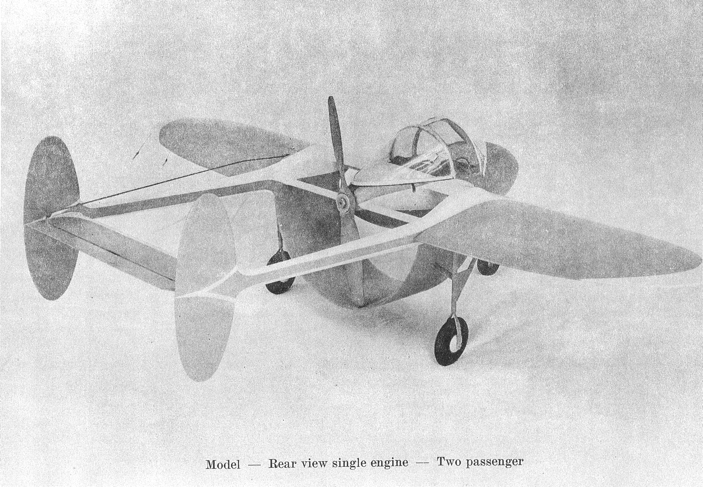Background
In the early 1950s, the Custer Channel Wing Corporation (CCWC) published a white paper touting all the potential capabilities of a Channel Wing aircraft. Included in that paper were pictures of a wooden model. The model had been built to present a 3-dimensional example of a two-seater, single-engine aircraft that was built beginning with the channel. This stood in contrast to all of Willard’s other models which showed ways to adapt the channel wing to existing aircraft.
Those pictures are reproduced at left.
In 1956, the CCWC licensed the Custer Channel Wing Manufacturing Company of McAllen, Texas to build two Channel Wing aircraft, one of which was this single-engine design. It was called the CCW-2
(Custer Channel Wing 2-seater) even though that name had already been used on a different aircraft. It was described as a personal aircraft that would evolve into a flying car, taking off and landing in the family’s backyard, folding its wing stubs on landing, and parking in the driveway. The McAllen company, however, did not last long enough to begin work on it.
Willard also patented the design in 1956 (design patent number D176839). The four drawings in that patent are reproduced below.
In 1960, the CCWC licensed the Fun-Kell Company to build a Channel Wing aircraft based on this same design. The developer was Gilbert Taylor, who had designed several conventional single-engine aircraft and sold hundreds of them over his career. In fact, Taylor had previously (1951) licensed with the CCWC to build two Channel Wing designs, one of which was a single-engine 2-seater, but he had been unable financially to follow through. Now he was being given a second chance. Over the next two years (1961, 1962) he designed and built what he called the Command Air,
a tiny aircraft with a wingspan of 20 feet, total length just 12 feet, and constructed of fiberglass over a metal frame. It sported sweptback wings like a jet and winglets (canard) in the nose. It was tail-less. Directly behind the cockpit were the engine and a single channel circumscribing a propeller. It looked very futuristic. Eventually the wings would be foldable, Taylor said, but not in the prototype. He predicted it would take off in 50 feet and land at ten or fifteen miles per hour. It would be the perfect flying car, he said, fitting nicely into the family garage. His second chance ended with a prototype that never flew because, once again, the funds ran out.





